
The Ericales are a large and diverse order of dicotyledons. Species in this order have considerable commercial importance including for tea, persimmon, blueberry, kiwifruit, Brazil nuts, argan, and azalea. The order includes trees, bushes, lianas, and herbaceous plants. Together with ordinary autophytic plants, the Ericales include chlorophyll-deficient mycoheterotrophic plants and carnivorous plants.

The Ericaceae are a family of flowering plants, commonly known as the heath or heather family, found most commonly in acidic and infertile growing conditions. The family is large, with c. 4250 known species spread across 124 genera, making it the 14th most species-rich family of flowering plants. The many well known and economically important members of the Ericaceae include the cranberry, blueberry, huckleberry, rhododendron, and various common heaths and heathers.

Vaccinium is a common and widespread genus of shrubs or dwarf shrubs in the heath family (Ericaceae). The fruits of many species are eaten by humans and some are of commercial importance, including the cranberry, blueberry, bilberry (whortleberry), lingonberry (cowberry), and huckleberry. Like many other ericaceous plants, they are generally restricted to acidic soils.
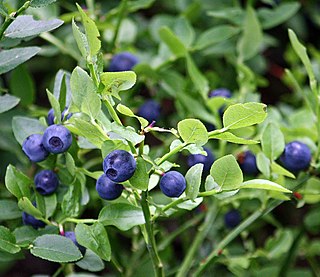
Bilberries, or in Europe blueberries, are a primarily Eurasian species of low-growing shrubs in the genus Vaccinium, bearing edible, dark blue berries. The species most often referred to is Vaccinium myrtillus L., but there are several other closely related species.

Empetrum is a genus of three species of dwarf evergreen shrubs in the heath family Ericaceae. They are commonly known as crowberries and bear edible fruit. They are commonly found in the northern hemisphere, from temperate to subarctic climates, and also in the Southern Andes of South America and on the South Atlantic islands of South Georgia, the Falklands and Tristan da Cunha. The typical habitat is on moorlands, tundra, muskeg and spruce forests. They are also often found in areas of coastal exposure on the sand dunes and dune slacks.

Gaylussacia is a genus of about fifty species of flowering plants in the family Ericaceae, native to the Americas, where they occur in eastern North America and in South America in the Andes and the mountains of southeastern Brazil. Common English names include huckleberry and "dangleberry".

Osmia ribifloris, one of several species referred to as a blueberry bee, is a megachilid bee native to western North America, including Oregon, California, Nevada, Utah, Arizona, New Mexico, Texas and northern Mexico. This solitary bee normally gathers pollen from plants in the family Ericaceae, with manzanita, Arctostaphylos sp. being a preferred host in the wild. It will pollinate blueberries, and is sometimes used commercially for this purpose.

Habropoda laboriosa, the southeastern blueberry bee, is a bee in the family Apidae. It is native to the eastern United States. It is regarded as the most efficient pollinator of southern rabbiteye blueberries, because the flowers require buzz pollination, and H. laboriosa is one of the few bees that exhibit this behavior. It is active for only a few weeks of the year, while the blueberries are in flower during early spring, when the temperature is warm and humid. H. laboriosa are solitary bees that live alone but nest in close proximity with other nests of their species. They have similar features to bumble bees, but they are smaller in size compared to them. H. laboriosa are arthropods so they have segmented bodies that are composed of the head, thorax, and abdomen.

Rhagoletis mendax is a species of tephritid fruit fly known by the common name blueberry maggot. The blueberry maggot is closely related to the apple maggot, a larger fruit fly in the same genus. It is a major pest of plant species in the Ericaceae family, such as blueberry, cranberry, and huckleberry. The larva is 5 to 8 mm long, apodous, and white with chewing mouthparts. Female adults are 4.75mm in length, males are slightly smaller. Both adults are mostly black in color with white stripes, orange-red eyes, and a single pair of clear wings with black banding. The adult female fly lays a single egg per blueberry, and when the larva hatches it consumes the fruit, usually finishing the entire berry in under 3 weeks and rendering it unmarketable. The larva then falls to the soil and pupates. Adult flies emerge, mate, and females oviposit when blueberry plants are producing fruit. Each female fly can lay 25 to 100 eggs in their lifetime.

Agarista is a genus of plants in the family Ericaceae. Agarista species contain grayanotoxins, a group of closely related neurotoxins named after Leucothoe grayana, native to Japan.
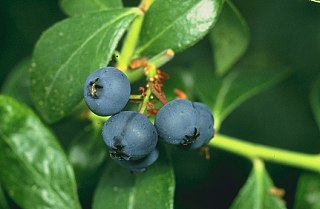
Blueberries are a widely distributed and widespread group of perennial flowering plants with blue or purple berries. They are classified in the section Cyanococcus within the genus Vaccinium. Vaccinium also includes cranberries, bilberries, huckleberries and Madeira blueberries. Commercial blueberries—both wild (lowbush) and cultivated (highbush)—are all native to North America. The highbush varieties were introduced into Europe during the 1930s.
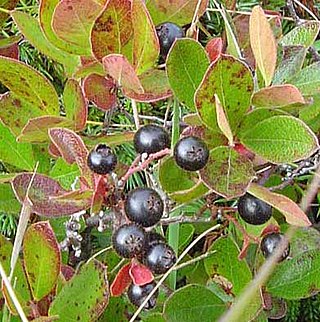
Huckleberry is a name used in North America for several plants in the family Ericaceae, in two closely related genera: Vaccinium and Gaylussacia.
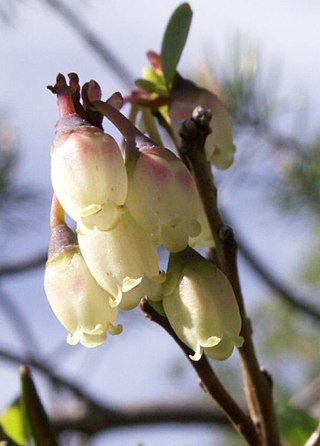
Vaccinieae is a tribe of over 1000 species in the plant family Ericaceae. The tribe consists of morphologically diverse woody plants. Species within Vaccinieae can be found on all continents except Australia and Antarctica. Genetic analysis indicates that Vaccinieae is not a monophyletic group.

Vaccinioideae is a flowering-plant subfamily in the family Ericaceae. It contains the commercially important cranberry, blueberry, bilberry, lingonberry, and huckleberry.

Macleania insignis, family Ericaceae is a member of the blueberry family—its most common ancestors in North America include blueberries and cranberries. The family Ericaceae is spread across the world, with a large concentration found in South America. This plant falls within the Neotropical subgroup and then Andean clade of this family. The Psammisia II section shares the closest common ancestor to this plant, and its closest split on a family tree is shared with Macleania coccoloboides and Macleania bullata. Phylogenic classification of M. insignis has primarily been carried out through an examination of morphological traits as well as genetic analysis. Macleania is an angiosperm eudicot, in the order of Ericales and the family Ericaceae.
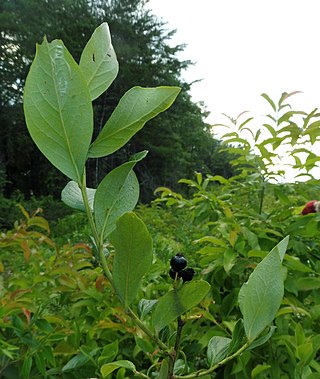
Vaccinium fuscatum, the black highbush blueberry, is a species of flowering plant in the heath family (Ericaceae). It is native to North America, where it is found in Ontario, Canada and the eastern United States. Its typical natural habitat is wet areas such as bogs, pocosins, and swamps.

Ceratostema is a genus of shrubs or dwarf shrubs and lianas in the heather family (Ericaceae).
Periclesia is a monotypic genus of flowering plants belonging to the family Ericaceae. It only contains one known species, Periclesia flexuosaA.C.Sm. It is also with the Vaccinioideae subfamily and the Vaccinieae tribe.
Costera is a genus in the Ericaceae found in the Malesian floristic region. It is a small genus of often epiphytic shrubs that grows in tropical rainforests.



















